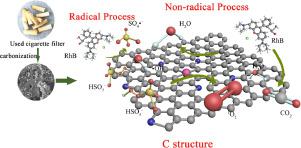Journal of the Taiwan Institute of Chemical Engineers ( IF 5.5 ) Pub Date : 2021-11-18 , DOI: 10.1016/j.jtice.2021.11.006 Sixian Huang 1 , Tianyou Hu 2 , Penghui Shi 1, 2 , Guohua Zhao 3 , Yulin Min 1, 2 , Qunjie Xu 1, 2

|
Background
The conversion of waste biomass into multi-hole carbon materials is an effective way in recent years. A new type of biochar was prepared by one-step calcination method by utilizing used cigarette filter (UCF) as raw material. In addition, we investigated the catalytic degradation properties of UCF, as well as the degradation mechanism.
Methods
The catalytic degradation properties of the material were verified by degradation experiments. The morphology of the material, and the microstructural state, were analyzed by SEM (Scanning Electron Microscope) and HRTEM (High Resolution Transmission Electron Microscopy). Using Raman, XRD (X-ray diffraction), BET, XPS (X-ray photoelectron spectroscopy) studied the structure and chemical composition of the material. The degradation mechanism was analyzed by quenching experiments and EPR (Electron Paramagnetic Resonance), XPS.
Significant findings
The first, UCF completely removed 0.01 g L−1 Rhodamine B within 80 min. And, degradation rate of Rhodamine B is as high as 95% within 20 min. Some defects were observed, and the dominant microporous structures and high specific surface area were present. The heteroatom in the UCF effectively activated the sp2-hybridized carbon crystal lattice, leading to the creation of more activation sites in UCF. Different carbide temperatures also affected the degree of material graphitization, and UCF (700 °C) had rich defects and larger porous structures. Besides, Electron paramagnetic resonance and quenching experiments showed that UCF degradation systems acted via free and non-radical pathways. The mechanism of catalytic degradation and the reasonable source of heterogeneous atoms at the catalytic site were also proposed. The use of the discarded cigarette filter as a low-cost catalyst for persulfate has great potential.
中文翻译:

通过回收废弃香烟过滤嘴激活过氧单硫酸盐:污染物的选择性降解
背景
将废弃生物质转化为多孔炭材料是近年来的有效途径。以废旧卷烟滤嘴(UCF)为原料,采用一步煅烧法制备新型生物炭。此外,我们还研究了 UCF 的催化降解性能以及降解机制。
方法
通过降解实验验证了材料的催化降解性能。通过SEM(扫描电子显微镜)和HRTEM(高分辨率透射电子显微镜)分析材料的形态和微观结构状态。利用拉曼、XRD(X射线衍射)、BET、XPS(X射线光电子能谱)研究了材料的结构和化学成分。通过淬灭实验和EPR(电子顺磁共振),XPS分析降解机制。
重要发现
首先,UCF 在 80 分钟内完全去除了 0.01 g L -1罗丹明 B。并且,罗丹明B在20分钟内的降解率高达95%。观察到一些缺陷,并存在主要的微孔结构和高比表面积。UCF 中的杂原子有效地激活了sp 2-杂化碳晶格,导致在 UCF 中产生更多的活化位点。不同的碳化物温度也影响材料的石墨化程度,UCF(700℃)具有丰富的缺陷和较大的多孔结构。此外,电子顺磁共振和猝灭实验表明,UCF降解系统通过自由基和非自由基途径起作用。还提出了催化降解的机理和催化位点异相原子的合理来源。使用废弃的香烟过滤嘴作为过硫酸盐的低成本催化剂具有很大的潜力。


















































 京公网安备 11010802027423号
京公网安备 11010802027423号